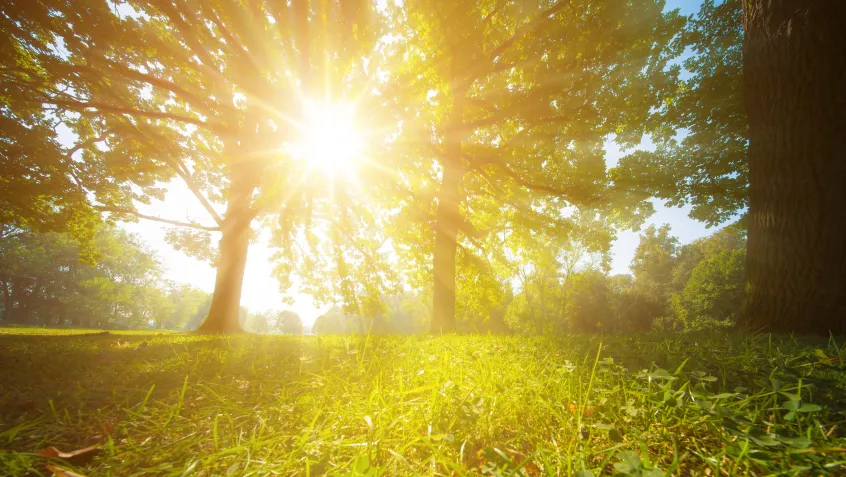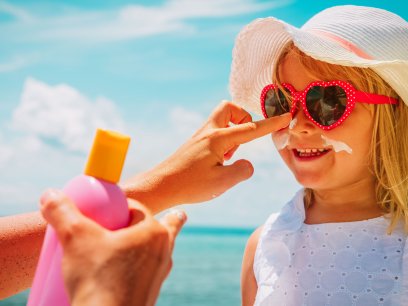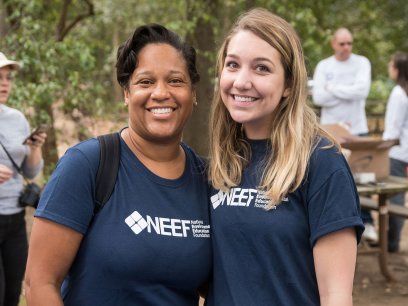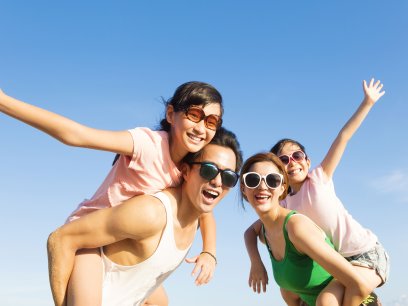
Ultraviolet (UV) radiation from the sun is responsible for the adverse health effects of too much sun exposure on the human body. Learn more about this type of radiation, the factors that mitigate its intensity, and methods you can use to protect yourself while having fun in the sun.
UV Radiation
The sun radiates energy over a broad spectrum of wavelengths. Ultraviolet (UV) radiation, which has a shorter wavelength than either visible blue or violet light and is not visible to the human eye, is responsible for sunburns and other adverse health effects. Fortunately for life on earth, our atmosphere's stratospheric ozone layer shields us from most UV radiation. What gets through the ozone layer, however, can cause the following problems, particularly for people whospend time outdoors without sun protection:
- Skin cancer
- Premature aging of the skin
- Suppression of the immune system
- Cataracts and other eye damage
Because of these serious health effects, you should limit your exposure to UV radiation and protect yourself when outdoors.
TYPES OF UV RADIATION
Scientists classify UV radiation into three types or bands—UVA, UVB, and UVC.
- UVA: Not absorbed by the ozone layer.
- UVB: Mostly absorbed by the ozone layer, but some does reach the earth's surface.
- UVC: Completely absorbed by the ozone layer and oxygen in the atmosphere.
UVA and UVB that reach the earth's surface contribute to the serious health effects listed above.
UV LEVELS DEPEND ON A NUMBER OF FACTORS
The level of UV radiation that reaches the earth's surface can vary, depending on many factors. Each of the following factors can increase your risk of UV radiation overexposure and its consequent health effects.
Stratospheric Ozone
The ozone layer absorbs most of the sun's UV rays, but the amount of absorption varies depending on the time of year and other natural phenomena. This absorption has also decreased as the ozone layer has thinned, due to the release of ozone-depleting substances that have been widely used in industry.
Time of Day
The sun is at its highest in the sky around noon. At this time, the sun's rays have the least distance to travel through the atmosphere and UVB levels are at their highest. In the early morning and late afternoon, the sun's rays pass through the atmosphere at an angle and their intensity is greatly reduced.
Time of Year
The sun's angle varies with the seasons, causing the intensity of UVB rays to change. UVB intensity tends to be highest during the summer months. The intensity of UVA rays is relatively constant throughout the year.
Latitude
The sun's rays are strongest at the equator, where the sun is most directly overhead and UV rays must travel the least distance through the atmosphere. Ozone also is naturally thinner in the tropics compared to the mid and high latitudes, so there is less ozone to absorb the UV radiation as it passes through the atmosphere. At higher latitudes the sun is lower in the sky, so UV rays must travel a greater distance through ozone-rich portions of the atmosphere and, in turn, expose those latitudes to less UV radiation.
Altitude
UV intensity increases with altitude because there is less atmosphere to absorb the damaging rays. Thus, when you go to higher altitudes, your risk of overexposure increases.
Weather Conditions
Cloud cover reduces UVB levels, but not completely. Depending on the type and thickness of the cloud cover, it is possible to burn—and increase your risk for long-term skin and eye damage—on a cloudy day.
Reflection
Some surfaces, such as snow, sand, concrete, or water, can reflect much of the UV radiation that reaches them. Because of this reflection, UV intensity can be deceptively high even in shaded areas.
Ozone: Good Up High, Bad Nearby
What is Ozone Anyway?
Ozone (O3) is made naturally in the atmosphere when three oxygen atoms join together to form a colorless gas. Ozone can have good or bad effects, depending on where it's located in the atmosphere. One way to remember this is, “good up high, bad nearby.”
Good Up High
The “Good” Ozone Layer: Earth's Sunscreen. The earth is wrapped in layers of air called the atmosphere. “Good” ozone is in the earth's upper atmosphere, 10 to 30 miles above the surface. Life couldn't exist without this protective ozone, which is also called the “ozone layer.” The sun gives off light, heat, and other types of radiation. Too much UV (ultraviolet) radiation can cause skin cancer, cataracts, and harm plants and animals. Ozone high in the atmosphere absorbs, or takes in, some of the sun's harmful UV rays before they reach the ground. Just as sunscreen helps protect your skin from getting burned, ozone up high works like earth's sunscreen.
The Ozone is Not a Hole
Although we say “hole in the ozone layer” or “ozone hole,” there's no actual hole. Instead, the protective layer contains less good ozone than it used to. This thinning is found all over the earth, but the biggest losses are over the North and South Poles. That's because ozone destruction is worse when it's very cold. To see current levels of ozone over the South Pole, go to: ozonewatch.gsfc.nasa.gov. The trouble with ozone destruction starts when certain chemicals used in air conditioners, fire extinguishers, insulating foams, and solvents are let out during use. These chemicals eventually reach the upper atmosphere and are broken down by the sun's radiation, releasing chlorine and bromine atoms. These atoms take away one of the oxygen atoms from ozone and use them to make other substances. Chlorine and bromine atoms are catalysts, meaning they can speed up a chemical reaction without changing, and can repeat the destructive cycle again with another ozone molecule. So one chlorine or bromine atom can destroy thousands and thousands of ozone molecules, causing ozone to disappear much faster than nature can replace it. People often confuse the ozone hole with global warming, but they are two different problems.
Is Anyone Doing Anything About the Ozone Hole (That's Not a Hole)?
The Montreal Protocol is an international treaty that protects the ozone layer by phasing out the manufacture and use of ozone-depleting chemicals. It was enacted in 1989, and all of the countries in the world have signed it. Many ozone-depleting chemicals are now illegal to use, or are only used in small quantities. Because of the Montreal Protocol, levels of most ozone-depleting chemicals in the atmosphere have slowly gone down. Based on current trends, scientists today expect
the hole to return to 1980 levels by 2070. Today, any products in the US containing CFCs and other ozone-depleting chemicals must have warning labels. The US also prohibits the release of refrigerants used in car and home air conditioners into the air because they still use ozonedepleting chemicals.
Why Can't We Just Make More Ozone?
Ozone molecules are constantly being made and destroyed by the sun's ultraviolet light in natural processes. Normally, the amount made and the amount destroyed is about the same, so nothing changes. Think of the amount of ozone as the water level in a bathtub with the faucet running and the drain open. If you turn on the water just right, you can make the amount of water leaving the bathtub equal to the amount coming in, so that the water level never changes. But right now, the drain has gotten faster, and the amount of ozone destroyed is more than the ozone being made. A big reason we can't make more ozone to send into the upper atmosphere is because it would take a LOT of energy. In the atmosphere, this huge amount of energy comes from the sun. We also don't have a way to transport the ozone to the right places in the atmosphere. Since we can't make more ozone, the solution is to slow the flow down the drain back to its normal rate. And the only way to do that is to stop using ozone-depleting chemicals.
Bad Nearby
What Causes “Bad” Ozone? “Bad” ozone is found at ground level. In cities, it's made when emissions from vehicles, power plants, chemical plants, and other sources react with heat and sunlight. The hotter the day and the stronger the sun, the more ground-level ozone is formed. That's why ground-level ozone is usually worse on windless, hot summer afternoons. High levels of groundlevel ozone are mainly a concern for people from April 1âSeptember 30. You're most likely to find high levels of “bad” ozone in urban areas. You might hear it called “smog.” However, other areas can also have high ozone levels when winds blow pollution hundreds of miles from their original sources.
How Does "Bad" Ozone Affect Me?
Even at low levels, breathing ozone can cause chest pains, coughing, nausea, throat irritation, and congestion. It can also worsen heart and lung diseases, like emphysema, bronchitis, and asthma. The more ozone pollution a person breathes, the
more permanent damage it can do to their lungs. Healthy people can also find it harder to breathe when exposed to ozone pollution. Because it usually forms in hot weather, anyone who spends time outdoors in the summer may be affected, particularly children, older people, outdoor workers, and people exercising. Millions of Americans live in areas where ozone levels are higher than the national health standards, and should pay attention to ozone levels when the weather is hot and sunny.
Ways to Protect Your Health on Bad Ozone Days:
- Use the Air Quality Index (AQI). The AQI uses colors and numbers to tell you how much pollution is in the air: www.airnow.gov.
- Use the EPA's Activity Guidelines at your school and sports practices to keep your kids healthy: www.epa.gov/airnow/flag/school-chart-2014.pdf.
- Do outdoor activities early in the morning and after 6 p.m.
- Pay attention to any breathing or lung problems you might have.
How are We Dealing with Ozone Pollution?
The Clean Air Act Amendments of 1990 require the US Environmental Protection Agency, the states, and cities to carry out programs that reduce emissions of ozone-forming chemicals from sources like cars, industry, power plants, and consumer products. Power plants are reducing emissions, companies are developing cleaner cars and fuels, many gas stations are using special nozzles at the pumps to recapture gasoline vapors, and vehicle inspection programs are being improved to reduce emissions.
What Can I Do?
We can control some things, and some things we can't. Here are some things you can do. And remember, lots of small steps add up to big differences!
To Limit "Bad," Nearby Ozone
- Keep your car tuned-up and running well.
- Carpool, use mass transit, walk, bicycle, and plan trips efficiently to reduce driving, especially on hot summer days.
- Be careful not to spill gas when filling up your car or gas-powered lawn equipment. During the summer, fill your gas tank during cooler evening hours.
- Make sure your car's tires are properly inflated and your wheels are aligned.
- Participate in your local utility's energy conservation programs.
- Seal containers of household cleaners, workshop solvents, and garden chemicals to prevent chemicals from evaporating into the air. Dispose of them properly.
To Protect "Good" Ozone Up High
- Have your car, home air conditioner, and refrigerator checked for leaks.
- Make sure that the technicians working on your air conditioners and refrigerator are certified to recover the refrigerant, as required by law.
- Find out from your local government the best way to get rid of old refrigerators and air conditioners.
What is the UV Index?
Some exposure to sunlight can be enjoyable; however, too much could be dangerous. Overexposure to the sun's ultraviolet (UV) radiation can cause immediate effects, such as sunburn, and long-term problems, such as skin cancer and cataracts. The UV Index, which was developed by the National Weather Service and the US Environmental Protection Agency (EPA), provides important information to help you plan your outdoor activities to prevent overexposure to the sun's rays. The UV Index provides a daily forecast of the expected risk of overexposure to the sun. The Index predicts UV intensity levels on a scale of 0 to 11+, where < 2 indicates a low risk of overexposure and 11+ signifies an extreme risk. Calculated on a next-day basis for every ZIP Code across the United States, the UV Index takes into account clouds and other local conditions that affect the amount of UV radiation reaching the ground in different parts of the country.
Sunwise Action Steps
By taking a few simple precautions daily, you can greatly reduce your risk of sun-related illnesses. To be SunWise, consider taking the following action steps daily:
- Do not burn.
- Avoid sun tanning and tanning beds.
- Generously apply sunscreen.
- Wear protective clothing, including a hat, sunglasses, and full-length clothing.
- Seek shade.
- Use extra caution near water, snow, and sand.
- Check the UV Index.
- Get Vitamin D Safely.
Early detection of melanoma can save your life. Carefully examine all of your skin once a month. A new or changing spot should be evaluated.
What is the UV Alert?
EPA issues a UV Alert when the level of solar UV radiation reaching your local area is predicted to be unusually intense for the time of year. The UV Alert is a warning, and it offers simple steps you can take to protect yourself and your family. The UV Alert consists of the SunWise action steps and is posted by zip code and city, state at www.epa.gov/sunsafety.
What Does the UV Alert Mean?
The UV Alert is based on the UV Index, which EPA provides with the support of the National Weather Service. EPA only issues a UV Alert when the UV Index is predicted to be 6 or higher and unusually intense for the time of year. In some parts of the United States, the UV Index rarely or never reaches this level, so your local area may never receive a UV Alert. UV Alert days are not the only days you need to protect yourself. EPA recommends that you take the SunWise action steps every
day, regardless of the season. Because children typically spend more time outdoors than adults, it is especially important that children take these steps. Even if you have darker skin, EPA recommends that you act SunWise to reduce your risk of skin cancer, cataracts, and other UV-related health problems.
Where Can I Find the UV INdex and UV Alert Forecasts for My Area?
You can find the UV Index and UV Alert forecasts for your area in your local newspaper, on television, and by visiting EPA's sun safety website at www.epa.gov/sunsafety. Enter your zip code. The resulting UV forecast will indicate if there is a UV Alert.
Protect Yourself from UV Rays
Use the UV (ultraviolet) index: The UV Index tells you how strong the sun's rays will be for the day: www.epa.gov/sunsafety.
- Don't get burned: Sunburns, especially for children, significantly increase the risk of getting skin cancer over your lifetime.
- Avoid sun tanning and tanning beds: The UV radiation causes skin cancer and wrinkling.
- Use enough sunscreen: At least 15 minutes before going outside, put sunscreen on all exposed skin. Sunscreen should have a sun protection factor (SPF) of at least 30 and provide broad spectrum protection from both ultraviolet A (UVA) and ultraviolet B (UVB) rays. Reapply every two hours, even on cloudy days, and after swimming or sweating.
- Wear protective clothing, such as a long-sleeved shirt, pants, a wide-brimmed hat, and sunglasses, when possible.
- Seek shade when you can. Remember, the sun's rays are strongest from 10 a.m. to 4 p.m.
- Use extra caution near water, snow, and sand: They reflect the sun's rays, which can increase your chance of sunburn.
- Get vitamin D safely: Choose foods fortified with Vitamin D. Don't seek the sun.
The Shadow Rule
Look for your shadow to estimate your UV exposure:
- If your shadow is taller than you are (in the early morning and late afternoon), you're probably getting less UV exposure.
- If your shadow is shorter than you are (around midday), you are getting higher levels of UV radiation. Seek shade and protect your skin and eyes.


